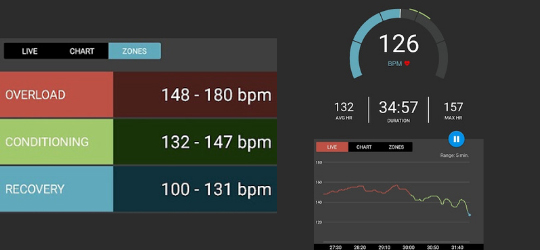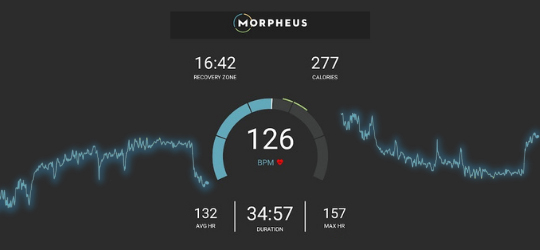One of the most important things Morpheus enables you to do is train in heart zones based on your recovery each day. The three Morpheus zones are based on a concept called dynamic heart rate training.
The biggest problem with the way heart training has traditionally been done is that the zones are entirely static. They never change and are only based on a percentage of your maximum heart rate.
There are two big problems with this approach. The first is that most people use the 220-age formula to determine their max heart rate.
That formula is outdated and research has shown it to be extremely inaccurate for most people. That’s because it was developed more than 50 years ago without any real research to even support it at the time.
It was also never intended to be applied across all ages and fitness levels in the first place.
The other big issue with the traditional approach to heart rate training is that even if you do use an accurate max heart rate, there is no connection to recovery. Your zones are always the same.
It doesn’t matter how fatigued or recovered you are.
The zones are the same either way, but that’s not how the body works.
Think about lifting weights. When you’re tired and sore, the bar feels heavier. It takes much more effort to get in the same number of reps. You can’t hit the same max numbers.
As we’ve discussed in previous lessons, fatigue and stress impact our bodies in many ways.
One of the most important of these is that they increase the cost of doing more work. This often decreases our ability to perform as a result.
That’s why heart rate training zones need to be dynamic and adjust to where your body is at each day.

How the Morpheus heart rate zones work
The Morpheus heart rate zones can help you improve your fitness faster because they are:
- Built around your recovery and adjust to your body on a daily basis. Not on static zones that never change.
- Take into account your overall fitness level and adapt as you get more fit.
- Use the latest science to estimate your max heart rate and update as you train so they’re accurate..
- Are designed to help you improve your recovery and conditioning without leading to overtraining
To make the zones as accurate as possible, you will need to do two things when you set up the Morpheus app.
First, select your fitness level between low, moderate, and high. You can always go back into the settings in the app at any time and change these fitness levels as necessary.
- Low – You have not been training recently and/or are just starting out.
- Moderate – You train recreationally a few times a week, but know you still have a lot of room to improve your overall fitness.
- High – You consistently workout 5-6 days a week and have a resting heart rate in the 50s and/or HRV in the 80s.
Second, if you know your max heart rate and/or anaerobic threshold from specific testing you’ve done, you can enter them into the app.
If you don’t, then you can start by letting Morpheus estimate your max heart rate based on the most recent and well-validated formula that it uses. If you achieve a heart rate higher than this during a workout, Morpheus will automatically adjust this for you.
Once you’ve completed these two steps, you’re ready to start getting in your zone.
Note that if you do not take a recovery score for the day, you will still see the colored zones. Instead of being dynamic based on your recovery, they will be set at your baseline levels derived from your fitness level and max heart rate.

The blue zone
The Morpheus blue zone is the low-to-moderate intensity zone and it’s designed to help you speed up recovery in two effective ways.
The first is through the recovery workouts we covered yesterday. Doing this type of training, with 30-45 minute workouts in your blue zone, will help drive blood flow and speed up recovery.
The second is that consistently training in the blue zone over time can help increase your average HRV and improve your body’s ability to adapt to all kinds of stress. That’s because training at lower and moderate intensities develops the aerobic system in some important ways that higher intensities do not.
The truth about intensity and fitness is you don’t need only low or only high intensity. There are unique benefits to different intensities. Your training should incorporate the full range of intensities across all three Morpheus zones.
A very general rule of thumb is that if your goal is to increase your aerobic fitness and conditioning, roughly 75-85% of your total training time across each month should be in your blue zone.

The green zone
The Morpheus green zone is a step up in intensity from the blue zone and as such, most workouts will end up with less overall time in it than the blue zone.
When you’re in the green zone, you’re tapping into more muscle fibers than when you’re in the blue zone. This also means you’re also driving much more oxygen throughout the entire body. This is an important part of developing aerobic fitness and why it’s called the conditioning zone.
Towards the middle and top of the green zone, you’ll also start tapping more and more into the anaerobic side of your body’s energy systems.
There are two anaerobic energy pathways that create energy without oxygen. They can produce energy much faster than the aerobic side, but the cost of this is they also lead to fatigue much faster as well.
The higher up you go in the green zone, the more you’ll be tapping into the anaerobic side. This will make it more and more difficult to keep going without hitting a wall and gassing out.
When you do higher intensity workouts, you should generally shoot for anywhere from 20-40% of the total workout time in the green zone.
Because your workouts should be a balance of higher and lower intensities, your overall weekly and monthly time in green should end up around 15-25% of the total time.

The red zone
The Morpheus red zone is the highest intensity and puts your body under the most stress. This is why it’s called the overload zone.
It puts the body under maximum load and taxes the aerobic system to its limits, while also pulling in energy from the anaerobic side as well.
This is important to drive your fitness to the highest levels, but the key is to be careful to not spend so much time in your red zone that your recovery suffers.
Because the intensity is at the highest levels, you generally don’t need more than a few minutes of time within the red zone in a workout to see the benefits. You also don’t need to drive your heart rate all the way up to the red zone every workout, either.
Depending on your fitness level, anywhere from 1-3 workouts per week with time in the red zone is all that’s needed. Averaged across a week or month, generally no more than roughly 8-10% of your total training time needs to be in your red zone to see continued results.
Action step
If you haven’t had a chance to put the Morpheus heart rate zones to the test yet, do a warmup and then spend 2 minutes in your blue zone, 2 minutes in your green zone, and then 2 minutes in your red zone.
This will give you a chance to see how each of the zones feel while you’re training. You can also repeat this on a day when you have a low recovery score to see how the zones dynamically adjust each day to meet you where your body is at.
